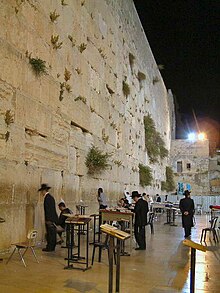Obama's private prayer published in Israeli newspaper
Saturday, July 26, 2008

Image: Chmouel.
When United States Democratic presidential candidate Barack Obama visited the Western Wall in Jerusalem to pray on Thursday, July 24, he left a prayer on a sheet of paper in the cracks as is traditional. A orthodox seminary student took the note and gave it to Israeli newspaper, Maariv. Obama is on an international tour to strengthen his foreign affairs credentials ahead of the November election.
Jewish clergy and others have expressed dismay at this personal violation of privacy. Rabbi Shmuel Rabinowitz, who is the supervisor of the Western Wall, told Israel Army Radio that it was a "outrage", and that "The notes placed between the stones of the Western Wall are between a person and his maker. It is forbidden to read them or make any use of them."

Analyst and director of the Orthodox Am Ehad think tank, Jonathan Rosenblum said, "It's inappropriate that the prayers of a person at the Western Wall should become a subject of public knowledge at all."
"There is a rabbinic prohibition against reading other people's private communications, and certainly anyone who goes to the wall expects that those communication will be protected," Rosenblum added.
Maariv has drawn significant criticism for the publication of the prayer. Other Israeli media have chosen to not publish the letter to respect Obama's privacy while many media sources outside Israel have printed the note or excerpts of it.
In the note, Obama did not pray for success in his election but rather prayed for protection for his family and forgiveness. The note ended with Obama asking for God to "help me guard against pride and despair. Give me the wisdom to do what is right and just. And make me an instrument of your will."
The Western Wall, often referred to as the Wailing Wall, is the lone remaining outer retaining wall of the second Jewish temple and is considered to be Judaism's holiest site. The temple, which was destroyed by the Romans in A.D. 70 was constructed on the same mountain ridge where King Solomon built the first Jewish Temple in the 10th century BC, which was destroyed by the Babylonians in 586 B.C. According to classical Jewish belief, the Temple (or the Temple Mount) acts as the figurative "footstool" of God's presence in the physical world.
Sources
- Tim McGirk. "Obama's Private Prayer 'Leaked'" — Time (magazine), July 25, 2008
- Aron Heller. "Israeli newspaper publishes Obama's private prayer" — Associated Press, July 25, 2008